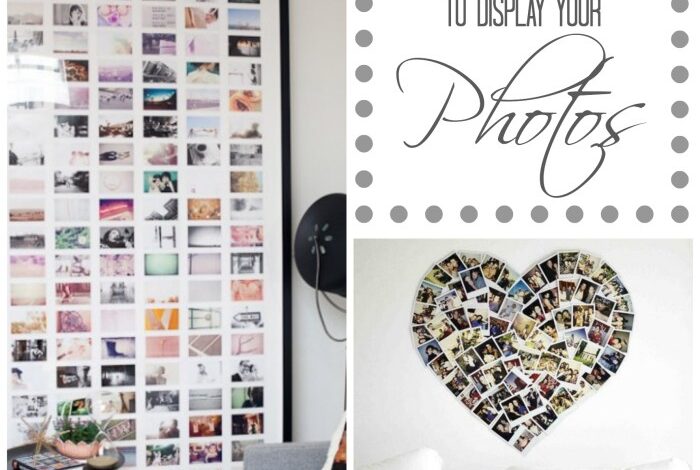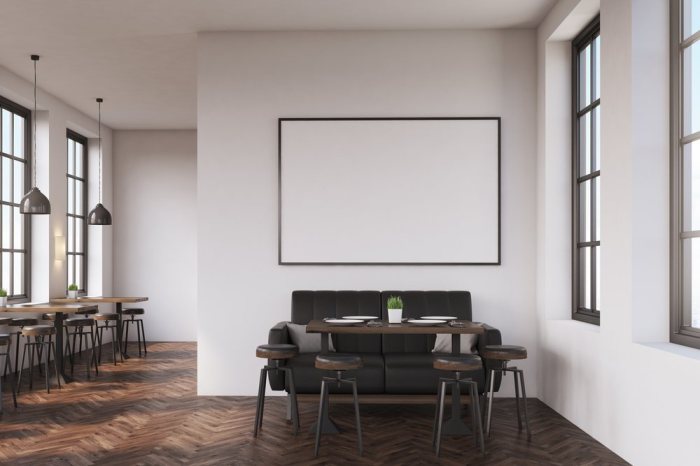
Make an oversized frame for a fraction of the price, and elevate your home décor with a statement piece. Oversized frames are a popular trend in interior design, adding a touch of elegance and grandeur to any space. They can make even the simplest artwork or photograph stand out, transforming a plain wall into a focal point.
But the cost of purchasing these large frames from traditional retailers can be prohibitive. This is where the DIY approach comes in. By building your own oversized frame, you can achieve the same stunning look without breaking the bank.
This guide will walk you through the entire process, from selecting materials and taking measurements to assembling the frame and adding finishing touches. We’ll cover everything from basic woodworking techniques to creative framing ideas, empowering you to create a masterpiece that reflects your personal style.
Understanding the Need for Oversized Frames
Oversized frames have become a popular trend in interior design, adding a dramatic and eye-catching element to any space. These frames can transform ordinary artwork or photographs into stunning focal points, instantly elevating the aesthetic appeal of a room.
Enhancing the Look of Artwork and Photographs
Oversized frames can significantly enhance the visual impact of various types of artwork and photographs. Here are some examples:
- Abstract Paintings:Oversized frames provide a bold and modern backdrop for abstract paintings, allowing the colors and textures to stand out even more. The frame’s size creates a sense of grandeur and emphasizes the painting’s abstract nature.
- Black and White Photographs:Oversized frames add a touch of classic elegance to black and white photographs. The large format draws attention to the details and contrasts in the image, creating a timeless and sophisticated look.
- Nature Photography:Oversized frames are perfect for showcasing breathtaking nature photographs, allowing viewers to immerse themselves in the scenery. The larger size enhances the feeling of scale and grandeur, bringing the beauty of nature into the home.
Challenges of Purchasing Oversized Frames
While oversized frames offer numerous benefits, purchasing them from traditional retailers can pose several challenges:
- Limited Selection:Many stores have a limited selection of oversized frames, making it difficult to find the perfect style and size to complement your artwork.
- High Costs:Oversized frames can be significantly more expensive than standard-sized frames, especially if you’re looking for high-quality materials and custom designs.
- Shipping and Handling:Oversized frames are bulky and difficult to transport, making shipping and handling costs a significant factor to consider.
Cost-Effective Framing Solutions
Creating an oversized frame doesn’t have to break the bank. With a little creativity and resourcefulness, you can achieve a stunning result without spending a fortune. Let’s explore some cost-effective framing solutions that will help you bring your vision to life.
Materials for Picture Frames
Choosing the right materials is crucial for achieving a sturdy and aesthetically pleasing frame. Let’s delve into the common materials used for framing and their associated costs.
- Wood:Wood is a popular choice for picture frames, offering a wide range of styles and finishes. The cost of wood varies depending on the type, quality, and thickness. For example, pine is a budget-friendly option, while hardwoods like oak or walnut can be more expensive.
- Metal:Metal frames offer a modern and sleek look. Aluminum is a lightweight and affordable option, while steel provides greater durability.
- Plastic:Plastic frames are lightweight, durable, and often the most budget-friendly option. They come in a variety of colors and styles, making them versatile for different projects.
- Foam Core:Foam core is a lightweight and inexpensive material commonly used for backing and matting. It’s also suitable for creating simple frames, especially for lightweight artwork.
Measuring and Cutting Wood for Frames
Precision is key when measuring and cutting wood for your frame. Here’s a step-by-step guide:
- Measure the artwork:Accurately measure the width and height of the artwork you’re framing.
- Determine frame dimensions:Decide on the desired frame width. Add the desired width to both the width and height of the artwork to determine the overall frame dimensions. For example, if your artwork is 12 inches wide and 16 inches high, and you want a 2-inch frame, the overall frame dimensions will be 16 inches wide and 20 inches high.
You know how much I love a good DIY project, especially when it saves me money. Recently, I needed an oversized frame for a new piece of art, and I didn’t want to pay an arm and a leg for it.
Then, I had a lightbulb moment while playing super bomberman r online switch with my friends – I could build the frame myself! It’s amazing how sometimes the simplest solutions are the best, and it’s all thanks to a little inspiration from my favorite online game.
Now, I’m going to share my DIY frame building secrets with you, so you can create your own masterpiece on a budget.
- Cut the wood:Using a miter saw or a handsaw, carefully cut the wood to the calculated dimensions. Ensure all four pieces are cut at a 45-degree angle to create a perfect miter joint.
- Test the fit:Before assembling the frame, dry-fit the pieces to ensure they fit together snugly. Make any necessary adjustments to the cuts if needed.
Tools and Equipment for Framing Projects
Having the right tools and equipment can make your framing project much easier and more successful. Here’s a list of essential tools:
- Miter saw:A miter saw is a powerful tool that provides precise cuts for framing.
- Handsaw:A handsaw is a versatile tool for cutting wood, especially for smaller projects.
- Measuring tape:A measuring tape is essential for accurate measurements.
- Level:A level ensures that your frame is perfectly aligned.
- Wood glue:Wood glue is used to bond the frame pieces together.
- Clamps:Clamps are used to hold the frame pieces together while the glue dries.
- Sandpaper:Sandpaper is used to smooth out any rough edges on the frame.
- Paint or stain:You can paint or stain the frame to match your décor or create a unique look.
DIY Frame Construction
Creating a frame from scratch is a rewarding project that allows you to personalize your artwork and save money. This section will guide you through the process of building a frame using basic woodworking techniques.
I recently discovered a genius way to make an oversized frame for a fraction of the price, and it involves using a simple piece of fabric! I actually got the idea from a tutorial on how to style a head wrap , where they used a similar technique to create a beautiful, dramatic headpiece.
The fabric frame is super lightweight and can be customized with different colors and patterns, so it’s perfect for adding a pop of personality to any room.
Choosing Materials
Selecting the right materials is crucial for a sturdy and aesthetically pleasing frame. Common choices include:
- Wood:Pine, oak, maple, and walnut are popular options for their durability and workability. Pine is affordable and lightweight, while hardwoods like oak and maple offer greater strength and a more luxurious look.
- MDF (Medium-Density Fiberboard):MDF is a cost-effective alternative to wood, providing a smooth and consistent surface for painting or staining. It is readily available in various thicknesses and sizes.
- PVC (Polyvinyl Chloride):PVC is a durable and moisture-resistant material, making it suitable for outdoor applications. It comes in various colors and finishes, offering a wide range of design possibilities.
Frame Construction Techniques
Several techniques can be used to assemble frame components, each offering different advantages:
- Miter Joints:Miter joints are the most common and visually appealing method for joining frame components. They create a clean, 45-degree angle at each corner, resulting in a seamless and professional finish.
- Rabbet Joints:Rabbet joints are used to create a recess in one piece of wood that fits snugly against the edge of another. They are particularly useful for constructing frames with a raised profile or molding.
- Dowel Joints:Dowel joints involve using dowels, small cylindrical pieces of wood, to join two pieces of wood together. They are strong and secure, but require precision drilling.
Simple Frame Construction Plan
Here is a simple frame construction plan for a standard 16×20 inch picture frame:
| Component | Material | Dimensions | Quantity |
|---|---|---|---|
| Frame Top | Pine (1×2) | 16 inches x 2 inches | 1 |
| Frame Bottom | Pine (1×2) | 16 inches x 2 inches | 1 |
| Frame Sides | Pine (1×2) | 20 inches x 2 inches | 2 |
| Backboard | MDF (1/4 inch) | 15.5 inches x 19.5 inches | 1 |
| Picture Mounting Strips | Pine (1/2 inch x 1/2 inch) | 15 inches x 1/2 inch | 2 |
Finishing Touches

Now that your frame is built, it’s time to give it the final touch! Finishing your frame can be a fun and creative process, adding personality and style to your artwork. Whether you prefer a sleek modern look or a rustic vintage feel, there are many options to choose from.
Want to make an oversized frame for a fraction of the price? Leather is a fantastic material for this, offering both durability and a rustic charm. Before you get started, make sure you check out these tips for sewing leather to ensure your project goes smoothly.
Once you’ve mastered the basics, you’ll be able to create a stunning frame that will be the envy of all your friends.
Painting
Painting is a versatile finishing technique that allows you to create a wide range of styles. It’s a great option for covering imperfections, achieving a specific color, or adding a decorative element. Before painting, it’s essential to prepare the surface.
Sanding the frame with fine-grit sandpaper will create a smooth, even surface for the paint to adhere to. You can also use a primer to help the paint adhere better and provide a more consistent finish. To apply paint evenly, use a high-quality paintbrush or roller.
Apply thin coats, allowing each coat to dry completely before applying the next. For a smooth finish, use a light sanding between coats. You can achieve different effects by using different paint techniques, such as dry brushing, sponging, or layering colors.
Staining
Staining is a great way to enhance the natural beauty of the wood while adding color and depth. It’s a good choice for frames made from wood species with attractive grain patterns. Prepare the frame surface by sanding it with fine-grit sandpaper to create a smooth, even surface.
This will allow the stain to penetrate the wood evenly. To apply stain, use a brush, cloth, or sponge. Work with the grain of the wood for a more natural finish. Apply thin coats, allowing each coat to dry completely before applying the next.
For a deeper color, apply multiple coats. You can also use a sealant to protect the stain and enhance its durability.
Distressing
Distressing is a technique used to give a frame an aged or worn look. It can be achieved using various methods, including sanding, scraping, and applying paint or stain unevenly.To distress a frame, use sandpaper or a wire brush to create scratches, dents, or other imperfections.
You can also use a hammer to create small dents or a paint scraper to remove paint in certain areas. For a more subtle effect, apply a layer of paint or stain and then distress it by sanding or scraping.
Mounting and Displaying Artwork: Make An Oversized Frame For A Fraction Of The Price

Once you have your oversized frame built, the next step is to mount and display your artwork. This involves carefully securing the artwork within the frame, ensuring its protection and enhancing its visual appeal.
Methods for Mounting Artwork
There are various methods for mounting artwork, each with its own advantages and drawbacks.
- Matting: Matting is a popular technique that involves placing a border of acid-free mat board around the artwork. This creates a visual separation between the artwork and the frame, enhancing its presentation and protecting it from direct contact with the glass.
- Glazing: Glazing refers to the use of glass or acrylic to protect the artwork from dust, moisture, and UV damage. Glass is a traditional choice, but acrylic is lighter and more shatter-resistant.
- Direct Mounting: In this method, the artwork is directly attached to the backing board of the frame, often using archival-quality adhesive. This technique is suitable for lightweight artworks, such as prints or photographs.
- Floating Mounting: Floating mounting creates a three-dimensional effect by suspending the artwork slightly off the backing board. This technique is often used for artwork with textured surfaces or those that need to be displayed without direct contact with the frame.
Choosing Mounting Materials, Make an oversized frame for a fraction of the price
The choice of mounting materials depends on the type of artwork, its size, and the desired presentation.
- Mat Board: Acid-free mat board is the preferred choice for matting artwork. It is available in various colors and textures to complement the artwork.
- Glass: Glass provides excellent protection against dust, moisture, and UV damage. However, it is heavy and can be prone to breakage.
- Acrylic: Acrylic is a lightweight and shatter-resistant alternative to glass. It is also UV-resistant, offering good protection for artwork.
- Adhesive: For direct mounting, use archival-quality adhesive that is acid-free and non-yellowing. This ensures the adhesive will not damage the artwork over time.
Securing Artwork Within the Frame
Properly securing the artwork within the frame is crucial to prevent damage and ensure its longevity.
- Matting and Glazing: When using matting and glazing, secure the artwork to the mat board using archival-quality adhesive or mounting tape. The mat board is then attached to the backing board using mounting points or clips.
- Direct Mounting: For direct mounting, carefully adhere the artwork to the backing board using archival-quality adhesive. Ensure the adhesive is applied evenly and that the artwork is securely attached.
- Floating Mounting: Floating mounting typically involves using spacers or mounting clips to suspend the artwork off the backing board. The spacers or clips are attached to the backing board and the artwork, creating a small gap between them.
Step-by-Step Guide to Mounting Artwork
Here is a step-by-step guide to mounting artwork within an oversized frame:
- Prepare the Artwork: Clean the artwork with a soft, dry cloth to remove dust and debris.
- Cut the Mat Board: If using matting, cut the mat board to the desired size, leaving a border around the artwork.
- Attach the Artwork to the Mat Board: Use archival-quality adhesive or mounting tape to secure the artwork to the mat board.
- Attach the Mat Board to the Backing Board: Secure the mat board to the backing board using mounting points or clips.
- Install the Glazing: If using glazing, carefully place the glass or acrylic sheet over the artwork and mat board. Secure it using glazing clips or points.
- Assemble the Frame: Assemble the frame around the artwork, mat board, and glazing. Ensure the frame is properly aligned and secure.
- Hang the Artwork: Once the frame is assembled, hang the artwork using appropriate hanging hardware.
Creative Framing Ideas
Beyond traditional frames, the world of framing offers a canvas for creativity, allowing you to personalize your artwork and add a unique touch to your space. Think outside the box and explore unconventional framing techniques, repurposed materials, and eye-catching designs that elevate your artwork and showcase your individual style.
Reclaimed Materials for Unique Frames
Embrace sustainability and add a touch of vintage charm by repurposing materials into frames. Reclaimed wood, old window frames, and even salvaged metal can be transformed into unique and eco-conscious framing solutions. The imperfections and history inherent in these materials add character and texture, creating a one-of-a-kind frame that complements your artwork’s aesthetic.
Three-Dimensional Framing Techniques
Create depth and dimension by experimenting with three-dimensional framing techniques. Shadow boxes, floating frames, and layered frames offer a way to add visual interest and highlight the artwork’s texture or form. For instance, a shadow box can showcase a collection of pressed flowers or vintage ephemera, adding depth and context to the artwork.
Floating frames create a sense of levitation, making the artwork appear to hover against the wall.
Eye-Catching Framing Styles
Go beyond the ordinary with unique framing styles that make a statement. Consider bold colors, unexpected materials, or unconventional shapes. A frame with a distressed finish can complement a vintage photograph, while a brightly colored frame can add a pop of energy to a modern print.
Frames with geometric shapes, such as hexagons or triangles, offer a contemporary twist on traditional framing.






